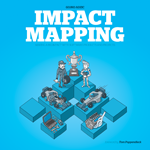Why should you care?
Impact mapping is a strategic planning technique. It prevents organisations from getting lost while building products and delivering projects, by clearly communicating assumptions, helping teams align their activities with overall business objectives and make better roadmap decisions.
Our products and projects do not work in a vacuum. They have an interdependent, dynamic relationship with people, other projects, the organisation and the wider community around them. Yet currently popular planning methods either expect the world to stand still while we deliver or give up on creating any kind of long-term big-picture view, leaving a huge communication gap between business sponsors and delivery teams. Impact maps visualise the dynamic relationship between delivery plans and the world around them, capturing the most important assumptions as well as delivery scope. They help us adapt plans effectively and react to change, while still providing a good road map for delivery teams and a big-picture view for business sponsors. Impact mapping helps to reduce waste by preventing scope creep and over-engineered solutions. It provides focus for delivery by putting deliverables in the context of impacts they are supposed to achieve. It enhances collaboration by creating a shared big-picture view for technical and business people.
Similar approaches to impact mapping are used in many proven management styles, including US and UK military Mission Command and workplace empowerment in commercial organisations, as well as several goal-oriented requirements engineering methods for software. Impact mapping has several unique advantages over similar methods:
-
It is based on a method invented by an interaction design agency and similar to a team-building method, which means that it facilitates collaboration and interaction. It is significantly less bureaucratic and much easier to apply than many alternatives. It also facilitates the participation of groups of people from different backgrounds, including technical delivery experts and business users, helping organisations use the wisdom of crowds.
-
It visualises assumptions. Alternative models mostly do not communicate assumptions clearly. Impact mapping does, and because of that it helps teams to make better decisions in rapidly changing environments such as IT. The visual nature of this method also facilitates effective meetings and supports big-picture thinking, which provides organisational alignment.
-
It is fast. One of my clients recently said that it would take them months to achieve what we did in just two days. Because of this, it fits nicely with iterative delivery models that are now becoming mainstream in software.
In essence, you should care about impact mapping because it can help you build products and deliver projects that make an impact, not just ship software.
